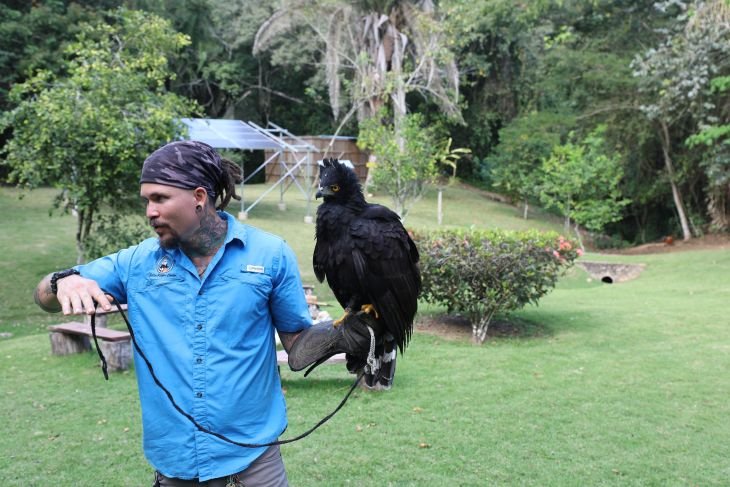The Tyrant Eagles of Belize
What is a Black Hawk-Eagle?
The black hawk-eagle (Spizaetus tyrannus) is a species of eagle found throughout Mexico, Central America, and South America. With its dark coloring, nearly five-foot (1.5 meter) wingspan, and carnivorous diet, the black hawk-eagle is a formidable sight in rainforests across its range. Its scientific name appropriately translates to “tyrant hawk-eagle.”
Image uploaded by user Samuelistok, 21 November 2013. Used under Creative Commons Attribution Share-Alike 3.0 Unported license.
As their name suggests, black hawk-eagles have primarily black or dark gray feathers across their back and wings, with the undersides of their wings checkered with white. Black hawk-eagles also have a distinctive crest of feathers (also called a facial disk), which can lie back flat or be pulled upright; this helps fine-tune their hearing when searching for prey. They typically weigh between 2 to 3 pounds (0.9 to 1.4 kg), but are vicious hunters and can target prey heavier than themselves. They most commonly feed on mammals, including rodents, squirrels, and even monkeys; black hawk-eagles in South America have been observed attacking howler monkeys! Additional prey consists of smaller bird species and reptiles, such as snakes and iguanas. Despite their status as diurnal (daytime) predators, black hawk-eagles have been known to feed on primarily nocturnal mammals including bats and opossums.
Black hawk-eagles live in rainforests, but can be found close to forest edges, including man-made forest clearings. This occasionally puts them in closer contact with humans than other hawk-eagle species, including the closely related ornate hawk-eagle (Spizaetus ornatus), which is found deeper in the rainforest. They are relatively common throughout their range; population estimates extend from 20,000 to over 100,000 individuals, and they are classified as Least Concern. However, their population is decreasing, as habitat destruction and close contact with humans begin to threaten the species as a whole.
Akna, a black hawk-eagle at the Belize Raptor Center, shows off her crest and checkered wings. Photo by Inspire EdVentures.
Black Hawk-Eagles of Belize
Belize’s black hawk-eagles are of the subspecies Spizaetus tyrannus serus. First identified as a subspecies by Herbert Friedmann in 1950, S. t. serusranges from central Mexico to Brazil and northern Argentina, and is characterized by its smaller size and the prevalence of white checkered plumage. The other subspecies, Spizaetus tyrannus tyrannus, is found solely in eastern Brazil and Argentina, and has noticeably less white markings on the undersides of the wings.
Though the population of black hawk-eagles in Belize is currently unknown, they are believed to be relatively common, as they are in other parts of their range. They can be seen flying above forest canopies or perched high in trees. Along with the ornate hawk-eagle, black hawk-eagles are sometimes called “curassow hawks,” referring to their habits of preying on birds, such as the great curassow. A great curassow can weigh up to 10 pounds (4.5 kg), making it three times the weight of its predator!
However, despite their non-endangered status, the prevalence of black hawk-eagles on forest edges can spell trouble for these birds. Black hawk-eagles often eat livestock, especially chickens, threatening the livelihood of Belizean farmers. Along with other raptors, they are often shot or poisoned to protect livestock from their predation. Forest fragmentation, a process in which large sections of rainforest are divided into pieces, often through human agriculture and construction, forces these birds into ever-increasing contact with humans, heightening the risk of conflict. Though Belize is a leader in habitat and wildlife conservation, with nearly 40% of the country’s rainforests now protected, habitat loss through rainforest destruction and fragmentation remains a threat to its native species.
Akna poses with her caretaker, Belize Raptor Center director Robert Howes. Taken in by the Belize Raptor Center after an injury to her legs and feet, Akna is unable to be released to the wild and instead acts as an ambassador for her species.
To learn more about Belize’s birds of prey and raptor conservation, book a virtual tour with the Belize Raptor Center at Raptors Live!
Kayla is a biologist and science writer specializing in ecology and conservation. She is a graduate from North Carolina State University and project manager for Inspire EdVentures since 2020.
References and Further Reading
Black Hawk-Eagles at The Peregrine Fund
Black Hawk-Eagles at GlobalRaptors.Org
Black Hawk-Eagles at The World Bird Database
Miranda, J.M.D., Bernardi, I.P., Moro-Rios, R.F. et al. “Antipredator Behavior of Brown Howlers Attacked by Black Hawk-eagle in Southern Brazil.” Int J Primatol 27, 1097–1101 (2006). https://doi.org/10.1007/s10764-006-9062-z
Friedmann, H. (1950). “The forms of the black hawk-eagle.” Smithsonian Miscellaneous Collections, 111(16), 1–4. http://hdl.handle.net/10088/22855
Weyer, Dora. “Diurnal Birds of Prey of Belize.” Hawk Trust Annual Report , vol. 14, pp. 22–39. https://sora.unm.edu/node/136561



